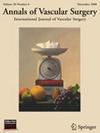影响透析通畅的患者因素:指导下肢动静脉通路创建决策的工具。
IF 1.6
4区 医学
Q3 PERIPHERAL VASCULAR DISEASE
引用次数: 0
摘要
下肢通道仍然是许多需要透析通道的患者的最后手段。我们试图确定影响下肢房室瘘(AVF)和移植物(AVG)通畅的患者因素,并创建一个临床工具来帮助指导这些复杂患者的决策。方法:2011-2023年在血管质量倡议透析模块中进行下肢通道创建的所有患者,根据通道是动静脉瘘(AVF)还是移植物(AVG)分为两组,并进行回顾性分析。进行单因素Kaplan-Meier和多变量回归分析,结果为总生存率和原发性/继发性通畅。对重要因素进行标准化和分级,以创建二级通畅丧失的评分。然后对该模型进行内部验证并导入临床计算器,以生成预测通畅丧失的评分(透析通畅估计评分)。结果:2011-2023年,1213例患者接受了下肢通道的建立,其中AVF 151例(12.45%),AVG 1062例(87.5%),1年内原发通畅率为52.18%,继发通畅率为77.56%,不同通路类型间原发通畅率差异无统计学意义(AVF 60.5%/AVG 50.9%, p=0.068), AVG继发通畅率较差(AVF 88.6%/AVG 74.3%, p= 0.013)。增加继发性通畅损失的因素包括:住院时间、年龄、BMI、PAD、糖尿病和既往AVF/AVG。对这些因素进行标准化和分级,形成一个0到100分的评分系统,以预测一年后继发通畅的丧失,评分为bbb56分接近100%的风险。该评分系统分为四组,以预测通畅丧失的风险(0-40 =低风险,41-50 =中低风险,51-55 =中高风险,56-100 =高风险)。结论:下肢AVG与AVF相比,其通畅程度较差,但更常放置。我们创建了一个风险分层评分,以确定哪些患者可能从下肢AVG中获益。本文章由计算机程序翻译,如有差异,请以英文原文为准。
Patient Factors Impacting Dialysis Patency: A Tool to Guide Decision Making for Creation of Lower Extremity Arteriovenous Access
Background
Lower extremity access remains a last resort for many patients needing dialysis access. We sought to identify patient factors impacting lower extremity arteriovenous fistula (AVF) and arteriovenous graft (AVG) patency and create a clinical tool to help guide decision-making in these complex patients.
Methods
All patients in the Vascular Quality Initiative dialysis module undergoing lower extremity access creation from 2011 to 2023 were separated into 2 cohorts based off whether the access was AVF or AVG and retrospectively analyzed. Univariate Kaplan–Meier and multivariable regression analyses were conducted with outcomes being overall survival and primary/secondary patency. Significant factors were standardized and scaled to create scores for loss of secondary patency. The model was then internally validated and imported into a clinical calculator to generate a score that was predictive of loss of patency (the Dialysis Patency Estimation score).
Results
In addition, 1,213 patients underwent creation of lower extremity access from 2011 to 2023 with 151 (12.45%) AVF and 1,062 (87.5%) AVG. One-year primary patency was 52.18% and secondary patency was 77.56% No difference was seen with primary patency based on access type (AVF 60.5%/AVG 50.9%, P = 0.068); however, AVG had worse secondary patency (AVF 88.6%/AVG 74.3%, P = 0.013). Factors increasing loss of secondary patency included: length of stay, age, body mass index, peripheral vascular disease, diabetes, and prior AVF/AVG. These factors were standardized and scaled to create a scoring system of 0 to 100 to predict loss of secondary patency at 1 year, with a score of >56 being near 100% risk. This scoring system was separated into 4 groups to predict risk of loss of patency (0–40 = low risk, 41–50 = medium low risk, 51–55 = medium high risk, and 56–100 = high risk).
Conclusion
Lower extremity AVG has inferior patency compared to AVF, but are more commonly placed. We have created a risk stratification score to determine which patients may benefit from a lower extremity AVG.
求助全文
通过发布文献求助,成功后即可免费获取论文全文。
去求助
来源期刊
CiteScore
3.00
自引率
13.30%
发文量
603
审稿时长
50 days
期刊介绍:
Annals of Vascular Surgery, published eight times a year, invites original manuscripts reporting clinical and experimental work in vascular surgery for peer review. Articles may be submitted for the following sections of the journal:
Clinical Research (reports of clinical series, new drug or medical device trials)
Basic Science Research (new investigations, experimental work)
Case Reports (reports on a limited series of patients)
General Reviews (scholarly review of the existing literature on a relevant topic)
Developments in Endovascular and Endoscopic Surgery
Selected Techniques (technical maneuvers)
Historical Notes (interesting vignettes from the early days of vascular surgery)
Editorials/Correspondence

 求助内容:
求助内容: 应助结果提醒方式:
应助结果提醒方式:


